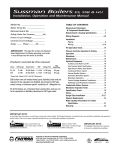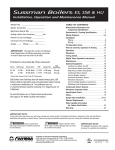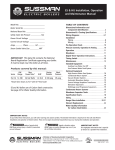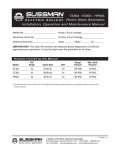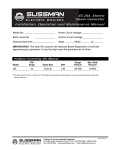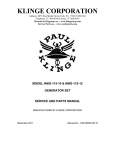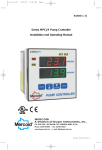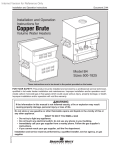Download SSB IOM - Sussman Electric Boilers
Transcript
SSB Installation, Operation and Maintenance Manual TABLE OF CONTENTS Model No. SSB- __________________ Boiler Serial No. _________________ Dimensional Information and Component Identification . . . . . . . . . . . . . . . . . 2 National Board No. Dimensional & Clearing Specifications . . . . . . . . . 3 ______________ Safety Valve Set Pressure________psig Wiring Diagrams . . . . . . . . . . . . . . . . . . . . . . . . . 4-5 Power Circuit Voltage Installation Piping, Wiring . . . . . . . . . . . . . . . . . . . . . . . . . . . 6 ____________ Control Circuit Voltage ___________ Pre-Operation Check . . . . . . . . . . . . . . . . . . . . . . . . 7 Amps _____ Phase _____ HZ ______ Pressure Controls, Operation & Testing . . . . . . . . 7 IMPORTANT: This data file contains the National Board Registration Certificate approving your boiler. It must be kept near the boiler at all times. Blowdown . . . . . . . . . . . . . . . . . . . . . . . . . . . . . . . . 8 Operation. . . . . . . . . . . . . . . . . . . . . . . . . . . . . . . . . 8 Timing Switch . . . . . . . . . . . . . . . . . . . . . . . . . . . . . 9 Digital Timer Operation Instructions. . . . . . . . . . 10 Maintenance . . . . . . . . . . . . . . . . . . . . . . . . . . . . . 11 SSB Boilers have Stainless Steel all wetted metal parts. SSB boilers shall be operated using only deionized water, having a maximum conductance of 1 microSiemen per cm (1 µS/cm) [minimum specific resistivity of 1 megohm per cm (1ΜΩ/cm)]. PRODUCTS COVERED BY THIS MANUAL: Standard Equipment Auxiliary Low Water Cut Off . . . . . . . . . . . . . . . . 12 Line Pressure Water Feed System . . . . . . . . . . . . . 12 Optional Equipment . . . . . . . . . . . . . . . . . . . . . . . 12 High Pressure Water Feed System . . . . . . . . . . . . . 12 Automatic Blowdown System . . . . . . . . . . . . . . . . 12 Blowdown Separators . . . . . . . . . . . . . . . . . . . . . 13 Control Voltage Stepdown Transformer . . . . . . . . 13 Multistage Load Progressive Sequencers . . . . . . . . 13 Max Series KW Range Steam Rate* BHP Design Pres. Work Pres. ______________________________________________________________________ SSB 12-180 36-542 lbs/hr 1.2-18.4 0-100 psig 85 psig Specification Charts . . . . . . . . . . . . . . . . . . . . . . . 15 *Steam Rate- Steam @ 212 F with 50 F feed water Sizing . . . . . . . . . . . . . . . . . . . . . . . . . . . . . . . . . . . 16 Blowdown Separator Tanks . . . . . . . . . . . . . . . . . 14 Gauge Glass Installation. . . . . . . . . . . . . . . . . . . . 17 Gauge Glass Use and Care . . . . . . . . . . . . . . . . . . 18 Element Replacement . . . . . . . . . . . . . . . . . . . . . . 19 IMPORTANT NOTE: As you follow these instructions, you will notice warning and caution symbols. This blocked information is important for the safe and efficient installation and operation of electric boilers. These are two types of potential hazards that may occur during this installation and operation: ! WA R N I N G states a hazard which may cause serious injury or death if precautions are not followed. ! C A U T I O N signals a situation where minor injury or product damage may occur if you do not follow instructions. IMPORTANT NOTE: This highlights information that is especially relevant to a problem-free installation. A Division of Sussman-Automatic Corporation 43-20 34th Street, Long Island City, NY 11101 • 718-937-4500 1-800-238-3535 • Fax: 718-937-4676 • email: [email protected] www.sussmanboilers.com MADE IN USA 3/13 PUR 101137SSB Installation, Operation & Maintenance Manual Dimensional Information & Component Identification Model SSB A B H M C K E J D F W G L _________________________________ SYMBOL ITEM SSB12-18 SSB 24-72 SSB 100 SSB 135-180 ___________________________________ 1 _______________________________________ WATER STEAM MODEL H W* L INLET OUTLET _______________________________________ 1 A Steam Outlet 6 ⁄4" 10" 8 ⁄4" 9" __________________________________________________________________ 1 1 B Steam Outlet 10 ⁄4" 17" 17 ⁄4" 18 1⁄4" __________________________________________________________________ C M/M Drain Valve 5" 12" 17" 16 3⁄4" __________________________________________________________________ 1 1 6" 6 ⁄4" 6 1⁄4" D M/M Drain Valve 6 ⁄2" __________________________________________________________________ E Check Valve 14" 9" 17" 16 3⁄4" __________________________________________________________________ 3 1 3 F PV Drain Valve 2 ⁄4" 2 ⁄4" 2 ⁄4" 2 3⁄4" __________________________________________________________________ G PV Drain Valve 6 1⁄4" 9 1⁄2" 7 3⁄4" 9 1⁄4" __________________________________________________________________ 3 1 J Clearance 3 ⁄4" 3 ⁄2" 4" 4" __________________________________________________________________ 1 3 K Check Valve 2 ⁄ 2 " 2 ⁄ 4 " 3" 3" __________________________________________________________________ 3 3 M Door Width 8 ⁄4" 14" 12 ⁄4" 14 3⁄4" __________________________________________________________________ SSB 12–18 37" 22" 32" 1/2”NPT 1/2”NPT _________________________________________________ SSB 24–72 47" 27" 36" 1/2”NPT 1” NPT _________________________________________________ SSB 80–100 63" 29" 36" 1/2”NPT 11⁄2”NPT** _________________________________________________ SSB 135–180 63" 30" 38" 1/2”NPT 2” NPT** _______________________________________ * Add 6 inches to the width when suppled with Automatic Blowdown ** Steam Outlet is 3” NPT on 15 PSI trimmed SSB-80-180. NOTE: Recommended clearance is 36 inches all around for servicing. 2 Installation, Operation & Maintenance Manual Dimensional & Clearance Specifications Steam Outlet Operating High Limit Pressure Pressure Pressure Gauge Control Control A Safety Valve On/Off Switch Gauge Glass Assembly Height Liquid Level Control EL D ER B Water Feed Inlet Drain Valve Left Front Width F Length Side Elevation Front Elevation Allow 24" all around for servicing. CLEARANCE FROM COMBUSTIBLE SURFACES A 1" Clearance above top of boiler B A Clearance from Front of boiler. Prefix "C" to numeral indicates acceptability for closet or alcove installations; prefix acceptability for alcove installations but not for closet installations. D 1" Clearance from back of boiler. EL 1" Clearance from left side of boiler. ER 16" Clearance from right side of boiler. F C Indicates type of flooring: "NC" for non-combustible; "C" for combustible. G - Total minimum free area in square inches of close ventilating openings. 3 Installation, Operation & Maintenance Manual Wiring Diagram Control Circuit 120V 1PH INPUT Control Terminal Block Pilot Light 2 7-Day 24 Hr Timer Open ES81600 Automatic Blowdown System Time Delay Relay 1 Close 3 Motorized Blowdown Valve ON/OFF SWITCH PILOT LIGHT S M SOLENOID VALVE PUMP MOTOR R RELAY C1 P1 P2 HIGH LIMIT PRESSURE CONTROL OPERATING PRESSURE CONTROL L LIQUID LEVEL CONTROL C2 CONTACTORS AUX LWCO 120V COM P2 1 P1 L 2 L2 RESET L1 GND LOW AUX LWCO PC BOARD 3 PROPORTIONING PRESSURE CONTROL HC COM NO PROBE P2 4 135 OHM COM SEQUENCER MANUAL RESET Field Wiring Factory Wiring BOILER SHELL 4 C1 C2 C3 C4 CONTACTORS Installation, Operation & Maintenance Manual Wiring Diagram Power Circuit FIELD WIRING FACTORY WIRING THREE PHASE MAIN POWER SUPPLY TB 1 SINGLE PHASE MAIN POWER SUPPLY L1 L2 TERMINAL POWER BLOCK (see note 1) L1 G L2 L3 PILOT LIGHT G TB POWER FUSES (see Note 2) FB1 FB2 FB3 FB4 480V FB T1 120V TRANSFORMER (optional) CONTACTORS C1 C2 C3 C4 C TO CONTROL CIRCUIT HEATING ELEMENTS NOTES: 1. Power Terminal Block only on boilers with two or more contactors 2. Power Fuses only on boilers rated 120 amperes and larger. 3. See Parts List for contactor and heating element information. H1 H3 H5 H7 H H2 H4 5 H6 H8 Installation, Operation & Maintenance Manual Wiring Installation REFER TO NATIONAL AND ALL APPLICABLE LOCAL CODES FOR SPECIFIC INSTALLATION REQUIREMENTS. 1. The boiler should be mounted on a solid, level foundation. 2. The boiler should be located with suitable clearances, refer to page 2 and 3 and Code requirements. Piping ALL PIPING SHOULD BE INSTALLED BY A QUALIFIED LICENSED PLUMBER IN ACCORDANCE WITH NATIONAL AND LOCAL CODES. 1. When water feed is other than pump type the water supply pressure must be 10 psig greater than boiler operating pressure to assure water supply maintains proper water level in the boiler. Insufficient water levels can result in improper boiler operation. (Keep feed water valves open at all times during normal operation.) 2. If pump and boiler are plumbed within 30 feet (pipe length) a minimum of 2 check valves are required to avoid damage to pump. 3. Connect steam line with customer supplied outlet valve to boiler steam outlet. 4. Provide for boiler drain connection, a daily blowdown is required. A "Blowdown Separator Tank" may be necessary, check with local code. 5. Safety valve shall be plumbed according to local code. 6. SSB Boilers have Stainless Steel all wetted metal parts. SSB boilers shall be operated using only deionized water, having a maximum conductance of 1 microSiemen per cm (1 µS/cm) [minimum specific resistivity of 1 megohm per cm (1ΜΩ/cm)]. NOTE: The safety valve shall not be plumbed with a line sized less than the outlet size of the safety valve. ALL ELECTRICAL WIRING MUST BE PERFORMED BY A QUALIFIED ELECTRICIAN IN ACCORDANCE WITH NATIONAL AND LOCAL ELECTRICAL CODES. ! C A U T I O N Assure that the power voltage and phase being supplied to the boiler matches the power voltage and phase of the boiler. Connecting incorrect power supply can damage boiler components or cause improper boiler operation. If the boiler power requirements do not match the power to be supplied to the boiler the boiler must be returned to the factory for conversion. Boilers cannot be field converted. All boilers are prewired and tested prior to shipment. 1. Ground boiler according to National Electric Code requirements to avoid shock. 2. Power wiring to boiler should be in accordance with National and Local Electrical Code requirements following wiring diagram supplied. Use proper size wire. Wire size is specified adjacent to field wiring terminals. This label states the wire size [AWG or MCM], minimum temperature rating (90 C) and conductor material (copper only). Deviation from these requirements may result in improper or unsafe boiler operation. 3. A disconnect switch employing circuit breakers or fuses should be installed between the main power source and the boiler. This disconnect switch should be located near the boiler and clearly marked for easy access and identification should the boiler need to be turned off due to an emergency. 4. Boiler control circuit is 120 Volt*. Unless boiler has an optional step down transformer, a separate 120 Volt power feed wiring is required to be connected to the control circuit terminal block. A 15 Amp circuit is required for all boilers. If a 3/4 HP feed water motor and pump assembly is connected to the boiler, then a 20 Amp circuit is required. 5. If a separate control circuit is used, it should be connected to the control circuit terminal block. 6. Remote mounted water feed systems (i.e. motor and pump) should be connected to the junction box provided on the outside of the boiler jacket. 7. With main power off, make sure all wiring terminations are tight to avoid arcing, carbonizing or overheating of contacts. ! CAUTION Boilers are susceptible to lightning damage due to water line connections. An industrial type lightning/surge protector should be installed according to the manufacturer's recommendation at the service entrance. Consult your contractor or electrical dealer. ! WARNING Substitution of components or modification of wiring system voids the warranty and may lead to dangerous operating conditions. *220V for 380V and 415V boilers. 6 Installation, Operation & Maintenance Manual Pre-Operation Check (All Boilers) LWCO/PUMP CONTROL OPERATION AND TESTING 1. All valves for incoming water supply are to be fully opened. Main disconnect switch is to be in the "on" position. Boiler main switch is to be in the "on" position. Since boiler will be empty the pump or solenoid will be energized allowing the boiler to fill with water. Control will automatically fill boiler to proper operating water level and the pump/solenoid will be de-energized. Contactors will then energize, applying voltage to the heating elements. 2. Pump switch operation – at this point water should be visible approximately half way up the sight glass. Slowly open the drain valve located at the bottom of the boiler. Water level in the sight glass will begin to drop, allowing the low water cut off/pump control to energize the feed water system. Close valve for proper operation. 3. Low water cutout switch performance – open the drain valve completely. Maintain this condition until water level falls within the gauge glass enough to cause the low water cutout switch to de-energize the heating elements. All of the contactors will be in a de-energized or open state at this time. Close the drain valve, water feed system will automatically refill the boiler and the contactors will re-energize. Boilers equipped with an auxiliary low water cut-off control with a manual re-set button (required as mandatory equipment is some states): once the correct operating water level has been reached, it will be necessary to depress the reset button in order for the contactors to re-energize. NOTE: For boilers equipped with an automatic blowdown system: • FOR TEST 1 - the blowdown time clock must be in the “run” mode before the boiler will automatically fill. • FOR TEST 2 AND 3 - in order for the drain valve to open the blowdown clock must be in the “off” mode. (See blowdown time clock insert) The automatic blowdown indicator light will be on when the valve is open. This light will remain on for the duration of the blowdown cycle (a few seconds). It may be necessary to cycle the time clock from the “run” to “off” mode several times. Pressure Controls, Operation and Testing NOTE: All boilers are provided with one high limit 4. Operating pressure control check: Close steam outlet valve [supplied by customer] and adjust operating pressure control to 20psig and the differential to 10psig. Set the high limit pressure control to 30psig. Switch boiler on to allow steam pressure to build-up. Pressure gauge reading will increase and the operating pressure control will deenergize the contactor(s) when the pressure gauge indicates 20psig. Open steam outlet valve to bleed off pressure. When the pressure gauge reading decreases below 10psig (differential) the operating pressure control will re-energize the contactor(s). 5. High limit pressure control check: FOR TEST PURPOSES ONLY! Set the high limit pressure control 10psig lower than the operating pressure control. Close the steam outlet valve and switch the boiler on to allow boiler to build pressure. When the pressure gauge indicates the pressure at which the high limit pressure control is set, the high limit pressure control re-set button will pop-up and the control will de-energize the contactor(s). Open the steam outlet valve to bleed off pressure. The contactor(s) should not re-energize on pressure drop. The contactor(s) should only re-energize when the pressure has dropped and the high limit pressure control reset button is depressed. pressure control and at least one operating pressure control. 1. The high limit pressure control is equipped with a manual reset feature. There is no subtractive differential scale with this type of control 2. All pressure controls are equipped with an adjusting screw, allowing for setting of desired operational and high limit pressures. To reduce pressure setting, turn adjusting screw in direction that allows indicator to point to a lower pressure setting on the scale. To increase pressure setting turn adjusting screw in direction that allows indicator to point to a higher pressure on the scale NOTE: It is recommended that the high limit control be set 10psig above the desired normal operating pressure. 3. Operating pressure controls, have a separate differential scale. Differential indicates pressure below the main operating maximum pressure, the pressure control will re-set. The differential set point is adjusted in the same manner by turning the adjusting screw in the desired direction to increase or decrease the differential pressure value. 7 Installation, Operation & Maintenance Manual Operation ! C A U T I O N With main disconnect “OFF” tighten all electrical connections before energizing boiler to prevent arcing, carbonizing of contact and/or overheating 1. Set the desired operating pressure and differential pressure on the operating pressure control. 2. Set the high limit pressure control. (Recommended to be 10 psig above the operating pressure setting.) 3. Turn on water supply. 4. Turn main disconnect switch on. 5. Turn boiler control switch on. The water feed will begin and continue until the water level reaches half way up the gauge glass. The water feed will automatically shut off and the contactor(s) will energize. 6. Boiler steam pressure will gradually increase to the operating pressure control set point, at which time the contactor(s) will de-energize. 7. With steam demand, the boiler steam pressure will decrease. When the boiler pressure has dropped below the operating pressure control differential set amount, the contactor(s) will reenergize. 8. The boiler is equipped with float type liquid level controls employing micro switches. They are extremely sensitive and reliable and will maintain the proper water level within the boiler pressure vessel automatically during boiler operation. 9. The boiler should be blown down daily. (See blowdown instructions.) Blowdown A daily blowdown is an essential part of boiler operation. It is the best and most important part of preventative maintenance you can give your boiler and will add years of life to the unit. Make sure a blowdown schedule is established and followed regularly. MANUAL BLOWDOWN INSTRUCTIONS AUTOMATIC BLOWDOWN INSTRUCTIONS 1. At the end of the working day, while boiler is still operating, turn boiler main switch to the “OFF” position, close water supply valve and open disconnect switch. 2. If blow down valve is plumbed into a blowdown tank, the boiler can be discharged at operating pressure. 3. If the blowdown valve is not plumbed into a blowdown tank, consult with local plumbing codes regarding boiler discharge. 4. When discharge is complete and boiler is drained, close the blowdown valve, open the water supply valve, turn boiler main switch to “ON” position and close disconnect switch. 5. When refilling is complete, turn off the boiler unless further operation is needed. 6. If boiler is equipped with a “Manual Re-set Auxiliary Low Water Cut-off” (as required in some states) the re-set button must be pushed before the boiler will begin developing steam. Do not push re-set button until the boiler has refilled with water. (PN ES81600) 1” NPT, Starts, stops and blows down the boiler automatically, utilizing a programmable time clock a timedelay relay and motorized ball valve. ! C A U T I O N If the blowdown valve is plumbed into a blowdown tank, the boiler can be discharged at operating pressure. If the blowdown valve is not plumbed into a blowdown tank, consult with local plumbing codes regarding boiler discharge. NOTE: The manual valves from the boiler drain and the lower float control equalization tube must be fully open for the automatic blowdown to be effective. 1. Program time clock by setting the time boiler is to turn on and off daily. (Refer to instructions in time clock insert.) 2. When the time clock turns the boiler “off” the blowdown is activated. A red pilot light over the time clock will come on and remain on while the motorized ball valve is open. The time duration the valve is open is set by an adjustable potentiometer built into the time delay board. The water level in the boiler after blowdown is complete, will be approximately at the lower gauge glass valve. (Elements are not exposed to air between operations.) 3. Boiler will automatically refill at next programmed on cycle. Blowdown program can be overridden to allow for unscheduled blowdown or operational cycles. Refer to the time clock instruction insert. 8 Installation, Operation & Maintenance Manual Digital Timer - Operation Instructions 14 TO SET TIME & DAY OF CLOCK 1. Press Menu 2. 24h AM or PM blinking, press 20 + or – to select, press OK 22 24 3. Hour (12:00) blinking, press + or – to select, press OK 4. Minute (12:00) blinking, press Res. Menu OK + + or – to select, press OK 5. Arrows for days blinking, +1h press + or – to select, press OK 6. Go to step 8 to continue with programming or press Menu to end. Mo Tu We Th Fr Sa Su 16 18 TO SET TIMER ON/OFF TIMES ON/OFF STATUS ON symbol displayed when timer is on and OFF symbol displayed when timer is off. OVERRIDE/AUTOMATIC When the timer is ON , press + to manually turn the timer OFF and display arrow will point to OVR. Press + again to go back to ON and display arrow will point to AUTO. When the timer is OFF , press + to manually turn the timer ON and display arrow will point to OVR. Press + again to go back to OFF and display arrow will point to AUTO. When the timer is in the override mode ( on OVR), timer will stay in that position until the next programmed time, at which time the arrow_will point to AUTO and continue in the automatic mode. 7. Press MENU and press OK four times to go current time/day setting above 8. PROG 01 blinking and ON symbol displayed, press + or – to select, press OK 9. Hour (12:00) blinking, press + or – to select, press OK 10. Minute (12:00) blinking, press + or – to select, press OK 11. Arrows for days blinking, press + or – to select, press OK 12. PROG 02 blinking and OFF symbol displayed, press + or – to select, press OK 13. Hour (12:00) blinking, press + or – to select, press OK 14. Minute (12:00) blinking, press + or – to select, press OK 15. Arrows for days blinking, press + or – to select. See possible combinations below. 16. Press MENU to end or press OK and repeat steps 8 to 15 to set more ON/OFF times. In the Run mode, use a pencil point and press + HR for Daylight Saving Time and current time advances one hour and + HR displayed. To revert back to Standard Time, press + HR and current time falls back one hour and + HR display disappears. PROGRAMMED DAY COMBINATIONS: PROGRAMMING CONFLICTS. Every day (arrows on all days) Monday to Saturday Monday to Friday Saturday and Sunday Any individual day HOURLY ON/OFF SETTING FOR THE DAY Hash marks on the upper and right edges of the display show the hourly On times for the day. Absence of hash mark on a specific hour indicates that the timer is Off on that hour. DAYLIGHT SAVING TIME. Switch Off commands have priority over switch On commands. NOTES: RUN MODE On Run mode, display will show current time/ date, on/off status, override/automatic status, hourly on/off setting for the day and Daylight Saving Time. 9 1. The timer is set according to the boiler operation. When the timer is ON the boiler is ON and the blowdown is OFF. 2. Timer must be powered up during programming to display ON/OFF status. 3. During programming, if no button is pressed after 1 minute, the timer will revert back to Run mode. Installation, Operation & Maintenance Manual 24-Hour and 7-Day Time Switches PROGRAMMING For electric steam boilers equipped with Automatic Blowdown Systems ES 81600, refer to the following instructions for time clock operation and settings. Timer settings for blowdown operation are at the discretion of the owner/operator. The weekly program dial shows the seven days of the week and AM/PM imprints for each day. The time switch is set by pushing the captive trippers to the outer ring position for the entire period that the load is to be turned ON, i.e., 2 hours to each tripper on the 7-day dial. When the tripper is pushed to the inside, the switch is in the OFF position. SETTING TIME To set the current time and day of week, turn the minute hand clockwise. Do not set the time by rotating “Outer” Dial. Turn the minute hand clockwise until the day of the week and the time of day on the outer dial is aligned with the triangle marker on the inner dial (two o'clock). Example for 7-day program dial Monday 10:30 AM.Turn the minute hand clockwise until Monday 10:30 AM is aligned with the triangle on the inner dial.The hour and minute hand will show exactly 10:30. FOR MANUAL OVERRIDE Manual override can be accomplished at the discretion of the owner/operator as follows. 3-WAY MANUAL OVERRIDE SWITCH I = permanent ON = automatic O = permanent OFF I O IMPORTANT: It is recommended that for periodic and effective blowdown,the override switch be set in the automatic setting. 10 Installation, Operation & Maintenance Manual Maintenance ! CAUTION HAZARD OF ELECTRIC SHOCK. DISCONNECT ALL ELECTRICAL POWER BEFORE WORKING ON BOILER. Sussman Electric Steam Boilers are designed for years of trouble-free performance. To establish a good preventative maintenance program, we suggest that the facility maintenance person or engineer familiarize themselves with these simple rules. 1. Daily blowdown at pressure is essential for ideal boiler performance. Extended periods of operation may require more frequent blowdown. If the boiler is not equipped with an automatic blowdown, in order to safeguard the heating elements, it is recommended to turn both the main disconnect switch and the boiler switch to the off position before manually blowing down the boiler. 2. The sight glass should be checked frequently to assure the boiler has adequate water. 3. The sight glass should be checked daily for damage (i.e. scratches, erosion, leaks etc.) The sight glass should be replaced if damaged. (See insert.) 4. A monthly inspection should be made of the internal wiring. Open the access door and check all electrical connections for tightness. Replace any wires that show signs of damage. NOTE: The electrical power MUST be shut off during this maintenance procedure. 7. Heating element mounting bolts should be checked and tightened to a torque of 22 ft.-lbs. If there are indications of steam leaks from an element, replace the element gasket. 8. A monthly check for leaks should be made; any loose or damaged fittings should be tightened or replaced. 9. Every four months the boiler float control should be checked for proper operation. The lower equalization column can be examined visually and manually to see if is clear and clean. If there are signs of scale or mineral deposit buildup the float control must be disassembled and cleaned. One of the lower heating elements should be removed. If scale or mineral deposits have begun to form all elements should be removed cleaned and reinstalled using new element gaskets. Operating and high limit pressure control operation should be checked. Pressure controls should be removed and cleaned if necessary. Water feed supply check valves should be inspected and replaced if necessary. 10. If the boiler is equipped with an electronic auxiliary low water cut-off every four months the probe should be removed and checked for deposits. The probe should be 11 cleaned and reinstalled. 11. Replace probe every 10 years. More frequent replacement of the probe is required if it is used in locales where significant water treatment is required. 12. Replace the auxiliary low water cut-off board every 15 years. 13. Perform low water condition test every 12 months and confirm auxiliary low water cut-off is operating as intended. AUXILIARY LOW WATER CUT-OFF TEST 1. To test the auxiliary low water cut-off, simulate the failure of the primary low water cutoff: 2. Turn off boiler power and control electric supplies. 3. Drain boiler. 4. Close water feed supply valve. 5. Open Mercoid level control cover to access its switches and terminal blocks. 6. Turn on boiler control voltage only. 7. Verify there is voltage at the yellow wire. 8. Manually work the upper switch to disable pump. 9. Manually work the lower switch to engage the heaters. 10. Pilot light near reset button will indicate low water after 30 seconds. 11. Release the switches. 12. Open water feed supply valve. 13. Allow boiler to fill at proper level. 14. Push manual reset button to energize contactors. 15. Install level control cover. Installation, Operation & Maintenance Manual Standard Equipment Optional Equipment AUXILIARY LOW WATER CUT OFF HIGH PRESSURE WATER FEED SYSTEM • For model SSB boilers SSB81017MR (with manual reset). • For model SSB12-72 PN SSB38002 Senses water level electronically using a resistance probe. When a low water condition is detected, the contactor control voltage circuit is interrupted and the heating elements are de-energized. When water level returns to proper levels voltage is restored to the contactor coils and the elements are re-energized. For controls with a manual reset button voltage to the contactor coils is not restored until the water level has returned to proper operating levels and the reset button is pushed. Do not depress the reset button before the correct water level is achieved. LINE PRESSURE WATER FEED SYSTEM • For model SSB boilers PN SSB99117 Water feed system used to supply makeup water to the boiler when incoming water line pressure is 10 psig greater than the operating pressure of the boiler. Completely factory plumbed and wired; 0-100psig range; 1/2” NPT size. Consists of strainer, solenoid valve (120/1/50-60Hz), and check valve for automatic feed. For SSB boilers PN SSB99117 components are of stainless steel construction. • For model SSB100-180 PN SSB38020 Used to supply makeup water and to maintain constant water level when the boiler operating pressure is equal to or greater than incoming water line pressure and condensate is not returned to the boiler. • SSB38002A – Range is 0 – 100 psig, 1/2” NPT size consisting of strainer, solenoid valve and 1/3 HP 120/1/60 motor and pump. • SSB38020A – Range is 0 – 125 psig, 3/4” NPT size consisting of strainer solenoid valve and 1/2 HP 120/1/60 motor and pump. These assemblies are mounted on rubber shocks and secured to a steel base mounting plate. These units require field plumbing and wiring to the boiler. SSB38002 and SSB38020 pump components are of stainless steel construction. AUTOMATIC BLOWDOWN SYSTEM • Extends life of boiler • Saves labor costs • Starts the boiler automatically every day • Shuts down the boiler every day • Automatically blows down the boiler every day • Completely programmable, can skip days, different start and shutdown times, different operational durations. • SSB81600 for all model boilers. A stainless steel, motor driven straight-through, selfcleaning ball valve with Teflon seats handles particles and dirty fluid without the use of an up-stream strainer or other cleaning device. A timer (Standard analog time clock is set for two hour time intervals, optional digital time clock can be programmed to one minute intervals.) and electronic time delay relay control the boiler and the blowdown valve. A pilot light indicates when the blowdown valve is open. The valve shall be plumbed to a proper drain or receptacle. An automatic blowdown system can be installed on any boiler, regardless of size operating pressure or operating duty cycle. 12 Installation, Operation & Maintenance Manual Optional Equipment (cont.) BLOWDOWN SEPARATORS (see page 14) • For models SSB12-48 PN BDT-ASME36 • For models SSB60-180 PN BDT-ASME42 A separator accepts the flash steam and effluent from the boiler blowdown and reduces the temperature and pressure to insure a safe discharge of water and sludge. Steam flash and pressure are absorbed and pass harmlessly to the outside via a vent. The separator design utilizes a water seal at the outlet, which permits the operator to introduce cold water from the bottom to mix with the hot water and boiler steam in the blowdown separator. This reduces outlet temperature to a safe discharge level. These separators require specific plumbing from the boiler blowdown valve and require connection to a cold water supply. (If the separator is less than half full of water after the boiler is blown down cold water must be added to bring the water level to the halfway mark before the next blowdown). • 0-30 PSIG pressure gauge; 0-200F temperature gauge; water sight gauge glass and valve set assembly are included. MULTISTAGE LOAD PROGRESSIVE SEQUENCERS Accurate control is provided by automatic progressive sequencing in the use of energy and minimizing wear on electrical components. The sequencers are designed to apply power progressively to larger KW boilers. A factory installed pressure sensitive sequential control reacting to steam boiler pressure progressive energizes or de-energizes heating elements through power contactors. A delay between sequencer steps before start-up and between each subsequent step eliminates power surges. Each sequencer is matched and factory pre- set to boiler system requirements. Electronic progressive sequencers give accurate control of multi-stage loads of the type used in steam boilers. Features include progressive sequencing (first on- first off) that equalizes the operating time of each load. Integral solid-state light emitting diodes show active stages. Should a power interruption occur, all elements are instantly de-energized for safety. Upon resumption of power the control will re-stage the loads one at a time. CONTROL VOLTAGE STEPDOWN TRANSFORMER • Provides 120 Volt (220 Volt export) from main power supply. Factory wired and fused. 13 Installation, Operation & Maintenance Manual Blowdown Separator Tanks- Specifications and Data MODELS BDT-ASME 36, 42 Dimensions and Features Suggested Hook-Up to Boiler Vent to atmosphere must be full size D Blowdown Separator Pressure Gauge Blowdown Inlet "E" Vent "B" Inlet A From Boiler Blowdown Outlets Water Gauge "C" Drain Temperature Gauge Handhole Assembly 3" x 4" H (except BDT-ASME 36) 3/4" Coupling for Temperature Probe (opt.) G "F" Cold Water Inlet & Washout Drain Tempered Blowdown to Drain Cold Water Supply Drain Valve (closed during normal operator) BOILER ________________________________________________ DIMENSIONS SHIPPING HP A B C D E F G H WEIGHT _______________________________________________________________________ BDT-ASME 36 0-5 18" 1" 2" 12" 2" 2" 14" 32" 125 _______________________________________________________________________ BDT-ASME 42 6-25 24" 1" 2" 16" 2-1⁄2" The Sussman Separator design incorporates a water seal at the outlet which permits the operator to introduce cold water from the bottom to mix with the hot water and boiler steam blowdown in the separator. This reduces the outlet temperature to a level that makes it safe for discharge. 2" 18" 42" 230 Maximum Boiler Working Pressure: 250 psi Maximum Blowdown Separator Pressure: 65 psi Blowdown Separators are sized in accordance with National Board Standards STANDARD EQUIPMENT • 0-100 lb. Pressure Gauge • 0-200˚ Temperature Gauge Note: 1BHP is approximately 10KW. • Water Level Gauge Constructed in accordance with Section VII Division I ASME Boiler & Pressure Vessel Code 14 Installation, Operation & Maintenance Manual Specifications __________________________________________ Boiler Bhp Lbs/Hr 3-Ph Rating Steam** Volts*** Amps Model No. KW __________________________________________ 208 34 240 29 480 15 __________________________________________ SSB-12* 12 1.22 36.2 208 50 240 44 480 22 __________________________________________ SBS-18* 18 1.84 54.2 208 67 240 58 480 29 __________________________________________ 208 84 SSB-30 30 3.06 90.4 240 73 480 37 __________________________________________ SSB-24* 24 2.45 72.3 208 100 SSB-36 36 3.67 108 240 87 480 44 __________________________________________ 208 134 240 116 480 58 __________________________________________ SSB-48 48 4.90 145 208 167 240 145 480 73 __________________________________________ SSB-60 60 6.12 181 208 200 240 174 480 87 __________________________________________ SSB-72 72 7.35 217 208 300 SSB-100 108 11.2 325 240 260 480 130 __________________________________________ 208 400 SSB-135 144 14.7 434 240 347 480 173 __________________________________________ 240 379 480 190 __________________________________________ SSB-160 158 16.2 475 240 434 SSB-180 180 18.4 542 480 217 __________________________________________ * Single phase available ** @ 212˚ F *** Other voltage available STEAM GAUGE PRESSURE/ TEMPERATURE CHART ________________ Gauge Temperature Pressure F˚ C˚ PSIG ________________ 179 82 15 ________________________ 10 192 89 ________________________ 5 203 95 ________________________ 0 212 100 ________________________ 1 215 102 ________________________ 3 221 105 ________________________ 5 227 111 ________________________ 9 237 114 ________________________ 11 241 119 ________________________ 15 250 121 ________________________ 17 253 123 ________________________ 19 257 125 ________________________ 21 260 127 ________________________ 23 264 129 ________________________ 25 267 131 ________________________ 27 270 132 ________________________ 29 273 134 ________________________ 31 275 135 ________________________ 33 278 137 ________________________ 35 281 138 ________________________ 37 283 139 ________________________ 39 286 141 ________________________ 41 288 142 ________________________ 43 290 143 ________________________ 45 292 144 ________________________ 47 295 146 ________________________ 49 297 147 ________________________ 51 299 148 ________________________ 53 300 149 ________________________ 55 303 151 ________________________ 60 308 153 ________________________ 65 312 156 ________________________ 70 316 158 ________________________ 75 320 160 ________________________ 80 324 162 ________________________ 85 327 164 ________________________ 90 331 166 ________________________ 95 335 168 ________________________ 15 100 338 170 ________________________ Installation, Operation & Maintenance Manual Sizing Use the following Table to determine KW Boiler rating when steam load and feedwater temperatures are known. _________________________________________________________ Feed Water 0 2 10 15 25 40 50 75 100 ( F˚) ___________________________________ ______________________ 40 .3347 .3355 .3375 .3388 .3406 .3422 .3431 .3447 .3458 _________________________________________________________ 50 .3318 .3326 .3345 .3359 .3376 ______________________ .3392 .3401 .3417 .3429 ___________________________________ 60 .3288 .3296 .3316 .3329 .3347 ______________________ .3363 .3372 .3388 .3400 ___________________________________ 70 .3259 .3267 .3287 .3300 .3318 ______________________ .3334 .3343 .3359 .3370 ___________________________________ 80 .3229 .3238 .3278 .3271 .3288 ______________________ .3305 .3313 .3329 .3341 ___________________________________ 90 .3200 .3208 .3238 .3242 .3259 ______________________ .3275 .3284 .3300 .3312 ___________________________________ 100 .3171 .3179 .3199 .3212 .3229 ______________________ .3246 .3255 .3271 .3283 ___________________________________ 110 .3142 .3150 .3170 .3183 .3200 ______________________ .3217 .3225 .3242 .3253 ___________________________________ 120 .3112 .3210 .3140 .3154 .3171 ______________________ .3287 .3196 .3212 .3224 ___________________________________ 130 .3083 .3091 .3111 .3124 .3142 ______________________ .3160 .3167 .3183 .3195 ___________________________________ 140 .3054 .3062 .3082 .3095 .3113 ______________________ .3129 .3137 .3154 .3165 ___________________________________ 150 .3025 .3032 .3052 .3066 .3083 ______________________ .3099 .3108 .3124 .3136 ___________________________________ 160 .2995 .3003 .3029 .3036 .3054 ______________________ .3070 .3079 .3095 .3107 ___________________________________ 170 .2966 .2974 .2994 .3001 .3025 ______________________ .3041 .3050 .3066 .3077 ___________________________________ 180 .2937 .2945 .2964 .2978 2995 ______________________ .3011 .3020 .3036 .3048 ___________________________________ 190 .2907 .2915 .2935 .2948 .2966 ______________________ .2982 .2981 .3007 .3019 ___________________________________ 200 .2878 .2886 .2906 .2919 .2937 ______________________ .2953 .2962 .2978 .2989 ___________________________________ Example: Need a boiler to produce 450 lbs. steam/hr. at 75 psig with the available feedwater temperature 50˚ F. From the chart above, find .3417 KW/Lb. of steam 450 lbs. steam/hr. x .3417= 153.8 KW boiler required 16 Installation, Operation & Maintenance Manual Gauge Glass Installation IMPORTANT NOTE: Read all warnings and instructions before performing installation or maintenance. Safety glasses and gloves should be worn at all times when working with or examining water gauge glass and connections. Pressure in generator to be at zero before proceeding. Improper installation or maintenance of gauge glass and connections can cause immediate or delayed breakage resulting in bodily injury and/or property damage. Top Gauge Fitting A Vessel Wall 1. Apply Teflon tape or pipe dope to pipe threads. Install top gauge fitting (fitting without a drain valve) into the uppermost tapping. Wrench tighten the fitting until it is snug and the glass outlet is pointing at five o'clock (about 1/8 turn from its final downward vertical position). 2. Install the bottom gauge fitting (the fitting with a drain valve) until it is snug and the glass outlet is pointing directly upward. Verify top and bottom fittings are threaded into the tappings the same number of turns (distance A= distance B). 3. Remove glass packing nut, friction washer (or packing gland, depending upon the model), and glass packing from the fittings, and place them, in the same order, on to both ends of the gauge glass. Push both packings about an inch up the gauge glass. 4. Gently insert one end of the glass into the top gauge fitting. Keeping the glass inside the top fitting, gently rotate the top gauge fitting clockwise until vertically aligned with the bottom gauge, then insert glass into bottom fitting until glass bottoms out on the shoulder inside the bottom fitting. 5. Carefully raise glass about 1/16" and slide lower glass packing down until the glass packing contacts the lower gauge fitting. DO NOT allow the glass to remain in contact with any metal! 6. Carefully slide upper glass packing up as far as possible. 7. Hand tighten both glass packing nuts, then tighten 1/2 turn more by wrench. Tighten only enough to prevent leakage. DO NOT OVER TIGHTEN! If any leakage should occur, tighten lightly, a quarter turn at a time, checking for leakage after each turn. Gauge Glass Guard Rod Glass Packing Nut Friction Washer (or Packing Gland) Glass Packing Bottom Gauge Fitting B Drain Valve ! WA R N I N G Safety glasses and gloves should be worn at all times when working with or examining water gauge glass and connections. Pressure in generator to be at zero before proceeding. Improper installation or maintenance of gauge glass and connections can cause immediate or delayed breakage resulting in bodily injury and/or property damage. IMPORTANT NOTE: Read all warnings and instructions before performing installation or maintenance. 17 Installation, Operation & Maintenance Manual Gauge Glass Installation - Use and Care DO NOTS MAINTENANCE • DO NOT use glass if it contains any scratches, chips, or any other visible signs of damage. • DO NOT subject gauge glass to bending or torsional stresses. Examine the gauge glass regularly for any signs of clouding, scratching, erosion, or corrosion. The glass should be inspected daily until the need for replacement becomes apparent. This will help establish the routine inspection and routine replacement schedules. • DO NOT over tighten glass packing nuts. CLEANING • DO NOT allow glass to touch any metal parts. • DO NOT exceed the recommended pressure of the gauge or gauge glass. Use commercial non-abrasive glass cleaners to keep glass clean. Do not use wire brushes or any other abrasive materials which could scratch the glass. • DO NOT clean the gauge or gauge glass while pressurized or in operation. INSPECTION • DO NOT reuse any tubular glass or glass packings. DO'S • DO verify proper gauge has been supplied. • DO examine gauge glass and packings carefully for damage before installation. • DO install protective guards and utilize automatic ball checks where necessary to help prevent injury in case of glass breakage. • DO inspect the gauge glass daily, keep maintenance records, and conduct routine replacements. Examine the surface of the glass for scratches, corrosion, chips, cracks, surface flaws, or nicks. To do this, shine a very bright concentrated light at an angle of about 45 degrees.A defective glass will glisten as the light strikes imperfections. Glass which appears cloudy or roughened, and will not respond to cleaning, should be replaced. STORING Keep gauge glass in original packaging until ready to install. • DO protect glass from sudden changes in temperatures such as drafts, water spray, etc. 18 Installation, Operation & Maintenance Manual Element Replacement READ INSTRUCTIONS COMPLETELY BEFORE STARTING WORK ! C A U T I O N Before Installing your new elements be sure the low water cut-off and aux. low water cutoff (if supplied) is operating properly. The float chamber and lower equalizer column of the liquid level control must be completely clear of sludge or other foreign matter. Failure to do this may cause the immediate burn-out of the new elements. If the unit is probe equipped, check condition of the probes and isolator. 1”Steam Equalizing Pipe Pump and LowWater Control Normal Boiler Water Line All elements are thoroughly checked before shipment The manu-facturer cannot be responsible for burn-outs caused by a faulty low water cut-off. The lower equalizer column can best be examined by breaking the unions on either side and then visually and manually examining the piping with your finger or probes to see if it is clear and clean. Cut-Off Level is ArrowMark 11⁄2” 1. Disconnect boiler from electric power supply at main safety switch or fuse panel. Then turn boiler switch to “OFF" position. Blowdown Valve 1”Water Equalizing Pipe Torque Values: 2. Close water supply valve on incoming water supply line. Drain boiler completely of water. Torque Wrench 3. Open boiler door to access heating element. 4. Disconnect wire (electric) leads connecting element to main power system of boiler. Again, note wire connections to facilitate re-assembly. Proceed to remove and discard (6) bolts from flange. Element Flange Bolts: 22 lb-ft IMPORTANT: Note the wire connections to facilitate re-assembly (see wiring schematic).Remove and discard six (5/16"-18) bolts from flange. Do not reuse these bolts. Torque Wrench 5. Thoroughly clean boiler flange of all foreign material. Be certain no part of old gasket remains on flange. 6. Apply "Slic-Tite" Gasket Compound (or equal) to both surfaces of new gasket supplied with replacement element. Proceed to install element flange assembly with gasket between boiler flange and element flange. In doing this, be careful to align flange holes so element wire connection terminals on element assembly are in line with previously disconnected wire leads to facilitate easy connections. Element Terminals: 20 lb-in NOTE: Observe markings on element flange. Install element marking “TOP” on top. 7. Use only new element flange bolts. Tighten all (6) element flange bolts to a torque value of 22 lb-ft each (see illustration). 8. Connect all wires to the terminals. Tighten all element terminals to a torque value of 20 lb-in each (see illustration). Make sure all wires are clean and bright to assure good electrical contact. Torque Wrench Contactor Terminals: see Torque chart 9. Check that the wires are correctly connected to the contactor terminals and are For Illustrative Purposes Only. tightened to a torque value of 45 lb-in. (see illustration). Make sure all wires are clean Power wiring shown in approximate and bright to assure good electrical contact. factory-installed location 10. Open water valve to allow water supply to reach boiler feed mechanism. 11. As boiler automatically refills, observe the new flange assembly for possible leaks. If water is noticed, the bolts must be re-tightened. Before doing this, turn the boiler off at the main fuse safety switch. 12. When boiler reaches working pressure, check flange assembly again for leaks. ! CAUTION Follow maintenance instructions provided with the boiler. 19 TORQUE VALUES Element Flange Bolts Element Terminals Contactor Terminals 50 amp 60 amp 75 amp 22 lb-ft 20 lb-in 25 lb-in 45 lb-in 75 lb-in A Division of Sussman-Automatic Corporation 43-20 34th Street, Long Island City, NY 11101 • 718-937-4500 1-800-238-3535 • Fax: 718-937-4676 • email: [email protected] www.sussmanboilers.com MADE IN USA 3/13 PUR 101137SSB




















